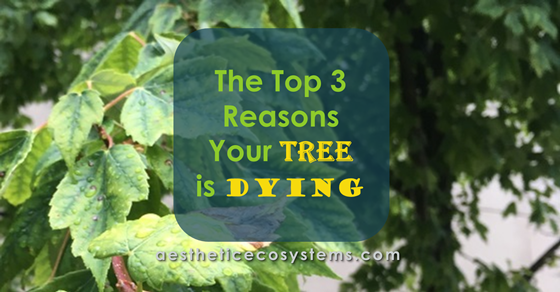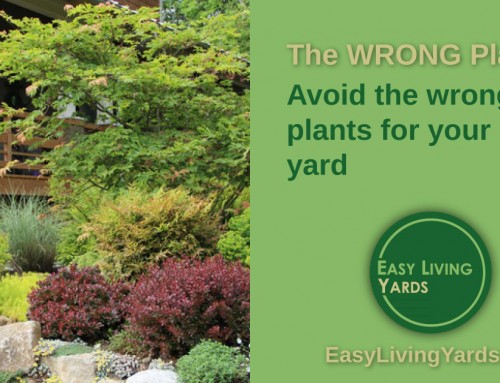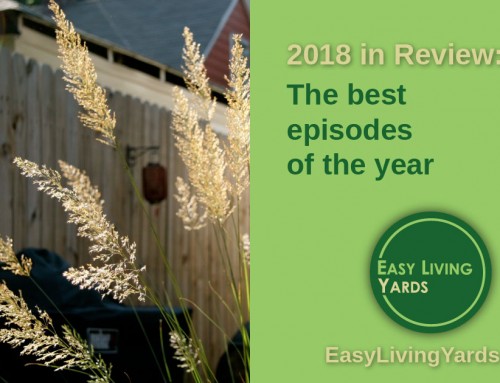When it comes to growing trees, you would think it’s so simple. You plant it in the ground, give it some water, give it some more water, let it grow, then enjoy. Right??? So why does your beautiful tree have disease problems? Why is your tree dying?
Let’s get out our detective hat and figure out what’s going on with your tree!
Reason # 1: Planting too deep
The absolute most common problem trees have is being planted too deep!
We have a tendency to make sure the roots are buried… a little too much.
Alert: Super quick plant biology lesson! (I warned you, nerd-haters!)
Trees evolved growing from seed and haven’t caught up to the human habit of transplanting. As part of this, we have exposed a weakness. When a tree develops from seed, its initial sprout shoots up from the seed, sending a taproot down to begin growth. As this development happens and the tree seedling emerges from the soil, it develops a super cool transition zone between roots and trunk that changes how nutrients are transported. This transition zone is often referred to as the root crown or root flare. This root crown must remain above the soil level, or problems may occur.
Ok – end of lesson. That wasn’t too bad, right?
Anyway, when we transplant a tree or mulch around it, the root crown often becomes partially or fully covered. This tiny mistake can cause widespread health problems or even death for the tree. The area becomes susceptible to many diseases.
So don’t bury your root crown – with soil or mulch.
How to fix it:
Okay Ben, that would have been helpful when I planted the darn thing. What now?
It’s difficult to tackle this issue post-facto. It depends how unhealthy your tree is as well.
You can try to uncover the root crown with a shovel while avoiding damage of the roots. This may be difficult if roots have grown upward to the surface. You can also pull out your garden hose and try spraying away soil.
If there’s mulch near the trunk, pull it back and let that root crown breathe
If you can’t properly uncover the root crown, it may be time to contact a good arborist who will try to save the tree if possible. Some arborists have tools that use pressurized air or water to uncover the crown or roots.
Reason #2 Spraying chemicals too close to the tree
Man, this one is a doozie. You don’t want any weeds in your yard or around your tree. So you go grab the weed&feed or RoundUp. Don’t do it!
Many lawn chemicals are broadleaf herbicides. That means it kills the veined-leaf plants like clover, dandelion, violet, etc. without killing the grass. Unfortunately, these chemicals can also affect trees.
The crazy thing is, even fertilizer can mess up trees. High nitrogen fertilizers can trigger abnormal growth phases that disrupt the health of the tree.
Trees send out wide root zones that can often extend beyond the canopy of the tree itself. The majority of root surface area is within the first few feet of soil, trying to capture as much moisture and nutrients as possible.
Unfortunately, the tree roots near the surface pull up the chemicals and suffer ill effects either immediately or over time.
How to fix it:
First, stop spraying near your root zone! Your tree may bounce back if not too far damaged.
If you must treat with chemicals, do so in a very controlled fashion, targeting plants directly with minimal soil contact or overspray. Use only the appropriate dose and dilution.
Even better, consider a natural, chemical free landscape. It is possible to have a lawn without chemicals that look beautiful.
For now, treat the root zone with a layer of compost or compost tea, careful not to cover the root crown at the base of the tree.
Reason #3: Planting at the wrong time
Trees everywhere go through a dormant phase. Wherever you live, it’s best to plant during this dormant phase.
What’s so cool about the dormant phase is that while the tree may appear inactive up top, there is very important activity underneath the soil. While the top is often dormant, the root zone uses stored energy to develop new roots and prepare for growing season.
In the northern US, this dormant phase is the winter. It’s best to plant in late fall after the summer heat and just before or right after leaf drop. The roots of the tree will become established over the winter as long as the roots aren’t completely frozen. Come spring, it will be much better off.
In drier states, the dormant phase is often mid-summer. During the high heat period, trees are just looking to conserve water and avoid becoming burned by the sun. Planting on the tail-end of this dry period is ideal, when the tree will have reduced heat and increased moisture to help establish.
How to fix it:
Ok I planted at the wrong time. Now what?
– Most likely, your tree needs a healthy water regime. This doesn’t necessarily mean more water. Depending on your climate and season, water appropriately. Your tree’s soil should be moist, but not saturated. It’s best to water deeply on occasion rather than small amounts on a regular basis. Water late evening or early morning. If your soil is saturated around the tree, it will drown from lack of oxygen in the root zone to promote proper soil life and healthy chemistry.
Add a top dressing of compost, followed by a few inches of mulch. This will help keep the soil moist and serve as an insulator. Make sure to avoid putting compost and mulch in contact with the root crown.
And there you have it! To summarize, the top three reasons your tree is dying are:
– Planting too deep
– Spraying chemicals within the root zone
– Planting at the wrong time
Want to learn even more? Get your free copy of 5 Common Problems with Tree Health!
Photo Credits: Easy Living Yards













Leave A Comment